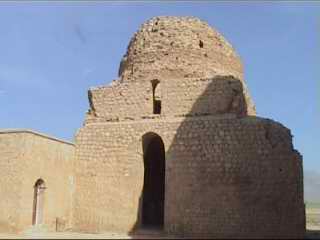Sarvestan Palace on:
[Wikipedia]
[Google]
[Amazon]


 The Sassanid Palace of Sarvestan () is a
The Sassanid Palace of Sarvestan () is a


 The Sassanid Palace of Sarvestan () is a
The Sassanid Palace of Sarvestan () is a Sassanid
The Sasanian Empire (), officially Eranshahr ( , "Empire of the Iranian peoples, Iranians"), was an List of monarchs of Iran, Iranian empire that was founded and ruled by the House of Sasan from 224 to 651. Enduring for over four centuries, th ...
-era building in the Iran
Iran, officially the Islamic Republic of Iran (IRI) and also known as Persia, is a country in West Asia. It borders Iraq to the west, Turkey, Azerbaijan, and Armenia to the northwest, the Caspian Sea to the north, Turkmenistan to the nort ...
ian city of Sarvestan
Sarvestan () is a city in the Central District of Sarvestan County, Fars province, Iran, serving as capital of both the county and the district.
The city is southeast of Shiraz, the capital of Fars province.
Many tropical and sub-trop ...
, some 90 km southeast from the city of Shiraz
Shiraz (; ) is the List of largest cities of Iran, fifth-most-populous city of Iran and the capital of Fars province, which has been historically known as Pars (Sasanian province), Pars () and Persis. As of the 2016 national census, the popu ...
. The palace was built in the 5th century AD, and was either a gubernatorial residence or a Zoroastrian
Zoroastrianism ( ), also called Mazdayasnā () or Beh-dīn (), is an Iranian religion centred on the Avesta and the teachings of Zarathushtra Spitama, who is more commonly referred to by the Greek translation, Zoroaster ( ). Among the wo ...
fire temple.
History
The Sarvestan Palace was built by the Sasanian king Bahramgur (; r. 420–438) and dominates an immense, empty plain. The name "palace" is considered misleading, because the monument's function is obscure. It may have been a hunting lodge or a sanctuary instead of a palace, because of the presence of a small building, just north of the palace, whose function remains unknown.Palace court
A visitor who would have arrived from the south, would have seen threeiwan
An iwan (, , also as ''ivan'' or ''ivān''/''īvān'', , ) is a rectangular hall or space, usually vaulted, walled on three sides, with one end entirely open. The formal gateway to the iwan is called , a Persian term for a portal projecting ...
s. After entering the central one, he would have reached a large square hall under a large dome, made of baked brick. After this, a visitor would have found himself on a rectangular courtyard, surrounded by the residential quarters. The building reminds one of the Ghal'eh Dokhtar and the palace of Ardashir, both near Firuzabad; the difference is that the Sarvestan palace is open to all sides. The building, made of stone and mortar, must have had fine decorations, which partly survive.
See also
*Iranian architecture
Iranian architecture or Persian architecture (, ''Me'māri e Irāni'') is the architecture of Iran and parts of the rest of West Asia, the Caucasus and Central Asia. Its history dates back to at least 5,000 BC with characteristic examples distr ...
* History of Persian domes
Persian domes or Iranian domes have an ancient origin and a history extending to the modern era. The use of domes in ancient Mesopotamia was carried forward through a succession of empires in the Greater Iran region.
An ancient tradition of royal ...
References
* J Homayooni (1996), ''History of Sarvestan''. Sarvestan Sasanian castles Buildings and structures in Fars province Buildings and structures on the Iran National Heritage List Sasanian palaces 5th century in Iran Buildings and structures completed in the 5th century {{castle-stub